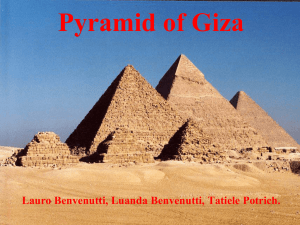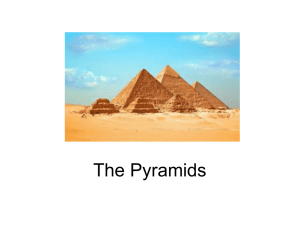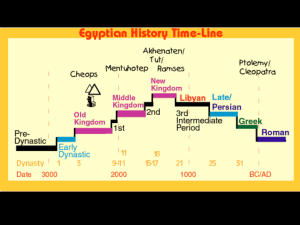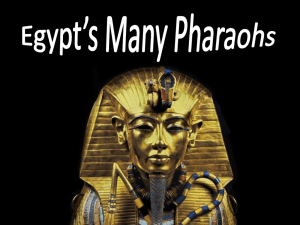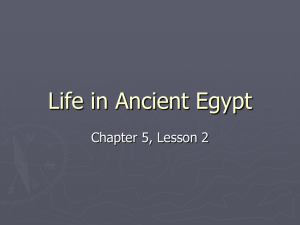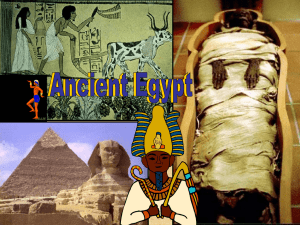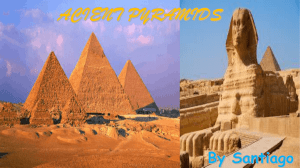Egyptian Dynasties
advertisement
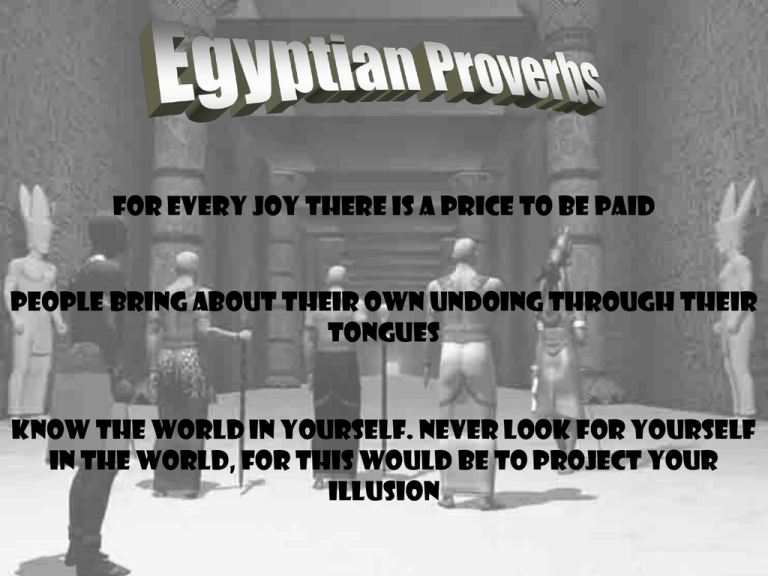
For every joy there is a price to be paid People bring about their own undoing through their tongues Know the world in yourself. Never look for yourself in the world, for this would be to project your illusion Chronological History Every Man is rich in excuses to safeguard his prejudices, his instincts, and his opinions. Social Good is what brings peace to family and society. Egypt Pre-Dynastic Period ~4000-3100 B.C. Country Exists as Nomes (Nomarch) or City-States Government Independent, yet cooperative economically Split into Upper & Lower Lasts as N (lower) & S (upper) until end of period Two Kingdoms • Lower Egypt consisted of Nile River Delta Symbol is Cobra (Red) • Upper Egypt consisted of higher ground of Nile to Nubia Symbol is Falcon (White) Racial Makeup • Not important as cultural development • Mediterranean strain of Caucasian Race • Short, Dark, Long Headed People • Straight Black Hair • Deep set Eyes • Ties w/ N&S Africa and Asia • Language contains Semitic elements Cultural Development • Tools – Flint, Copper, Gold • Pottery Glazed and Buffed • Excellent Irrigation, reclamation of swamp land • Weaving of woolen cloth • Laws based on custom, binding for all • System of writing • 1st Solar Calendar 12 months of 30 days + 5 feast days Began 4200 BC To water the crops, the Egyptians made a counterweight called the Shadoof. The Shadoof used the weight of the water vs. the weight of rocks to swing the water in mass quantities. The evolution of writing: Top, some signs dated several generations before the 1st Dynasty Center, the name of a city at the start of the 1st Dynasty; Bottom, a text from a wooden panel from the tomb of Hesyre Egyptian Dynasties 3 Major Great Periods During Egyptian Rule 30 dynasties ruled Egypt from 3100 BC to 525 BC Broken Down into 6 sub eras after the Pre-Dynastic Era Old Kingdom 3100 – 2200 BC • 3100 BC – Narmer unites Upper & Lower Egypt • Built new Capital City – Memphis • Central Location for Upper & Lower • 1st – 6th Dynasties Old Kingdom’s capitol – Memphis built by Narmer at the junction of upper and lower Egypt! Middle and New Kingdom’s capitol Thebes Old Kingdom • Form of Govt – Theocracy • Absolution of King • Named Pharaoh (Great or Royal House) • No Separation of Church & State • Developed Bureaucracy – Govt officials headed by Vizier (prime minister) – Treasurer, Architect, Public Works Adm, Chief Justice, 42 Monarchs Old Kingdom • Position of Pharaoh – Hereditary • High Quality Judicial System • Government – Peace, Non-Aggression (unique among ancient nations) – No standing Army, since existence was out of cooperative need – Only Local Militia • Content to let other nations alone, since Isolated in location Pharaoh’s (Old Kingdom) • Zoser (3rd Dynasty) 1st to build monumental structure to house remains. • With architect (Imhotep) engineered Step Pyramid at Sakkara • Stepped construction with facade of limestone • 200,000 tons of stone used Temple of Zoser Every man must act in the rhythm of his time…such is wisdom. All seeds answer light, but the color is different. The plant reveals what is in the seed. Pharaoh’s • Khufu (4th Dynasty) • Undertaking of Great Pyramids @ Giza • Estimated at 481 ft high, each side 755 ft long KHUFU THE GREAT PYRAMID •Ave. block weighs 5000 lbs and some granite blocks from Aswan weighed 30 tons! •Cut Precisely that a knife blade cannot be slipped between blocks Agents of the Gods During the Old Kingdom era, kings of Egypt began to emphasize their divine associations and their people believed them to be manifestations of the god Horus. After the time of Khufu, kings were also proclaimed to be sons of the great sun god Re. After his death, the king became associated with Osiris, father of Horus and god of the underworld. The king's sacred powers were passed on to the new ruler - usually his son. 1 Pyramid of Khufu 2 Pyramid of Khafre 3 Pyramid of Menkaure 4 Mrtuary temples 5 Causeways 6 Valley temples 7 Subsidiary pyramids 8 Boat pits 9 Cemeteries (mastabas) 10 Great Sphinx 11 Sphinx temple Egyptian Proverbs of the Day It is no use whatever preaching wisdom to men; you must inject it into their blood. The seed cannot sprout upwards without simultaneously sending roots into the ground. Organization is impossible unless those who know the laws of harmony lay the foundation. Pharaoh’s • Khafre (4th Dynasty) • Addition to Pyramids at Gizeh • Construction of Enormous Sphinx • Facial features inscribed on face Man fears Time, yet Time fears the Pyramids Arab proverb Unfortunately, the pyramids became obvious targets for tomb robbers. The Giza Pyramids were plundered long ago of the bodies and anything entombed with them, despite the almost superhuman efforts of the Egyptians to protect the remains of their kings. Plan Of Khafre The towering Grand Gallery is 8.7 meters high. It climbs up toward the King's Chamber. Note the steps and handrail at the bottom which were added in recent years. Sarcophagus Ascending Passage Kings Room Stairway Down The Treasure Room Entrance Pyramids – Pyramids - Pyramids • Zoser – 2630 BC – 204 ft High – stepped at Saqqara • Snefru – 2600 BC – 306 ft High – covered stepped; Bent Pyramid Dahshur 344 ft High; Northern Stone Pyramid 341 ft High • Khufuh - 2550 BC 481 ft High at Giza • Khafre – 2520 BC 471 ft High at Giza • Mencare – 2490 BC 310 ft High at Giza • Pepi II – 2250 BC 172 ft High at Saqqara Astronaut photograph ISS007-E-12915.was taken August 18, 2003, with a Kodak DCS760 digital camera equipped with an 800 mm lens and provided by the Earth Observations Laboratory, Johnson Space Center. The International Space Station Program supports the laboratory to help astronauts take pictures of Earth that will be of the greatest value to scientists and the public, and to make those images freely available on the Internet. Feudal Kingdom (2200-2050 BC) • Also called Intermediate Period • Period of Anarchy • Invasion of Negroid & Asian Tribes – No Standing Army becoming liability Feudal Kingdom (2200-2050 BC) •Power shifts to Monarchs, No Central Power •Drain of Treasury –Building Pyramids, Structures •Famine and Social Unrest •Broke into 2 separate Nations Once More FORGET THE BUD, CRACK open a Tut. Thanks to British archeologists and a Scottish brewery, you may soon be able to party like a pharaoh. Ancient Egyptians have long been known as prodigious beer drinkers, sipping brews both sociably and as medicine. Beer-making equipment has even been found in the tombs of Egyptian royalty-including King Tut's. Now, Cambridge University scientists studying hieroglyphics and wall paintings at the buried Clty of Armana believe they have deciphered the recipe for the Egyptian elixir, a bread-based ale flavored with anything from honey to flowers. The Scottish & Newcastle brewery hopes to tap kegs of Tut's suds by next year. Says exec Jim Merrington: "The product promises to be pretty palatable-and strong." The Egyptians made the wheat into bread and into soup and porridge, and they also added hops to make the barley into beer. In fact, some people think the real reason that the Egyptians first began growing grain was to make beer. This is an Egyptian model of beer jars (from the Louvre), which the Egyptians made to put in your grave when you died so you would have beer in the next world. A Japanese beer maker has taken a 4,400-year-old recipe from Egyptian hieroglyphics and produced what it claims is a brew fit for the Pharaohs. The Kirin Brewery Co. has called the concoction Old Kingdom Beer. It has no froth, is the color of dark tea and carries an alcohol content of 10% - about double most contemporary beers. Sakuji Yoshimura, an Egyptologist at Waseda University in Tokyo, helped transcribe the recipe from Egyptian wall paintings. Kirin spokesman Takaomi Ishii said: ''It has a taste very different from today's beer. It tastes a little like white wine.'' Drinkers will have to stick to normal ales. Old Kingdom is not for sale The beer is based on barley, but does not use hops, which give modern beer its bitter taste, Mr Ishii said. However, don't expect the brew to be drawn from a pump in your local. In 1996, British beer maker Scottish and Newcastle sold a limited edition, 1,000bottle batch of beer brewed according to an ancient Egyptian recipe. A bottle of its Tutankhamen Ale sold for ($78). Dr. Zahi Hawass http://www.guardians.net/hawass/

